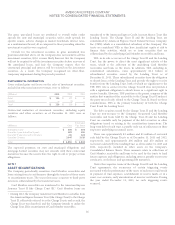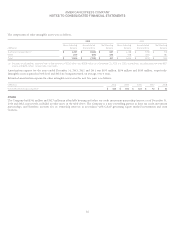American Express 2013 Annual Report Download - page 91
Download and view the complete annual report
Please find page 91 of the 2013 American Express annual report below. You can navigate through the pages in the report by either clicking on the pages listed below, or by using the keyword search tool below to find specific information within the annual report.
AMERICAN EXPRESS COMPANY
NOTES TO CONSOLIDATED FINANCIAL STATEMENTS
DERIVATIVE FINANCIAL INSTRUMENTS THAT QUALIFY FOR HEDGE
ACCOUNTING
Derivatives executed for hedge accounting purposes are documented
and designated as such when the Company enters into the contracts.
In accordance with its risk management policies, the Company
structures its hedges with terms similar to that of the item being
hedged. The Company formally assesses, at inception of the hedge
accounting relationship and on a quarterly basis, whether derivatives
designated as hedges are highly effective in offsetting the fair value or
cash flows of the hedged items. These assessments usually are made
through the application of a regression analysis method. If it is
determined that a derivative is not highly effective as a hedge, the
Company will discontinue the application of hedge accounting.
FAIR VALUE HEDGES
A fair value hedge involves a derivative designated to hedge the
Company’s exposure to future changes in the fair value of an asset or a
liability, or an identified portion thereof that is attributable to a
particular risk.
Interest Rate Contracts
The Company is exposed to interest rate risk associated with its fixed-
rate long-term debt. The Company uses interest rate swaps to
economically convert certain fixed-rate long-term debt obligations to
floating-rate obligations at the time of issuance. As of December 31,
2013 and 2012, the Company hedged $14.7 billion and $18.4 billion,
respectively, of its fixed-rate debt to floating-rate debt using interest
rate swaps.
To the extent the fair value hedge is effective, the gain or loss on
the hedging instrument offsets the loss or gain on the hedged item
attributable to the hedged risk. Any difference between the changes in
the fair value of the derivative and the hedged item is referred to as
hedge ineffectiveness and is reflected in earnings as a component of
other expenses. Hedge ineffectiveness may be caused by differences
between the debt’s interest coupon and the benchmark rate, primarily
due to credit spreads at inception of the hedging relationship that are
not reflected in the valuation of the interest rate swap. Furthermore,
hedge ineffectiveness may be caused by changes in the relationship
between 3-month LIBOR and 1-month LIBOR, as well as between the
overnight indexed swap rate (OIS) and 1-month LIBOR, as basis
spreads may impact the valuation of the interest rate swap without
causing an offsetting impact in the value of the hedged debt. If a fair
value hedge is de-designated or no longer considered to be effective,
changes in fair value of the derivative continue to be recorded through
earnings but the hedged asset or liability is no longer adjusted for
changes in fair value resulting from changes in interest rates. The
existing basis adjustment of the hedged asset or liability is amortized
or accreted as an adjustment to yield over the remaining life of that
asset or liability.
Total Return Contract
The Company hedges its exposure to changes in the fair value of its
equity investment in ICBC in local currency. The Company uses a
TRC to transfer this exposure to its derivative counterparty. As of
December 31, 2013 and 2012, the fair value of the equity investment in
ICBC was $122 million (180.7 million shares) and $295 million (415.9
million shares), respectively. To the extent the hedge is effective, the
gain or loss on the TRC offsets the loss or gain on the investment in
ICBC. Any difference between the changes in the fair value of the
derivative and the hedged item results in hedge ineffectiveness and is
recognized in other expenses in the Consolidated Statements of
Income.
The following table summarizes the impact on the Consolidated Statements of Income associated with the Company’s hedges of its fixed-rate
long-term debt and its investment in ICBC for the years ended December 31:
Gains (losses) recognized in income
(Millions) Derivative contract Hedged item Net hedge
ineffectiveness
Derivative relationship
Income Statement
Line Item
Amount Income Statement
Line Item
Amount
2013 2012 2011 2013 2012 2011 2013 2012 2011
Interest rate contracts Other expenses $(370) $(178) $ 128 Other expenses $ 351 $ 132 $(102) $ (19) $ (46) $ 26
Total return contract Other non-interest revenues $ 15 $ (53) $ 100 Other non-interest revenues $ (15) $ 54 $ (112) $— $1$(12)
The Company also recognized a net reduction in interest expense on
long-term debt of $346 million, $491 million and $503 million for the
years ended December 31, 2013, 2012 and 2011, respectively, primarily
related to the net settlements (interest accruals) on the Company’s
interest rate derivatives designated as fair value hedges.
CASH FLOW HEDGES
A cash flow hedge involves a derivative designated to hedge the
Company’s exposure to variable future cash flows attributable to a
particular risk. Such exposures may relate to either an existing
recognized asset or liability or a forecasted transaction. The Company
hedges existing long-term variable-rate debt, the rollover of short-
term borrowings and the anticipated forecasted issuance of additional
funding through the use of derivatives, primarily interest rate swaps.
These derivative instruments economically convert floating-rate debt
obligations to fixed-rate obligations for the duration of the
instrument. As of December 31, 2013 and 2012, the Company did not
hedge any of its floating-rate debt using interest rate swaps.
For derivatives designated as cash flow hedges, the effective portion
of the gain or loss on the derivatives is recorded in AOCI and
reclassified into earnings when the hedged cash flows are recognized
in earnings. The amount that is reclassified into earnings is presented
in the Consolidated Statements of Income in the same line item in
which the hedged instrument or transaction is recognized, primarily
in interest expense. During the years ended December 31, 2013, 2012
and 2011, the Company reclassified nil, $(1) million and $(13) million,
respectively, from AOCI into earnings as a component of interest
expense. Any ineffective portion of the gain or loss on the derivatives
is reported as a component of other expenses. If a cash flow hedge is
89
























